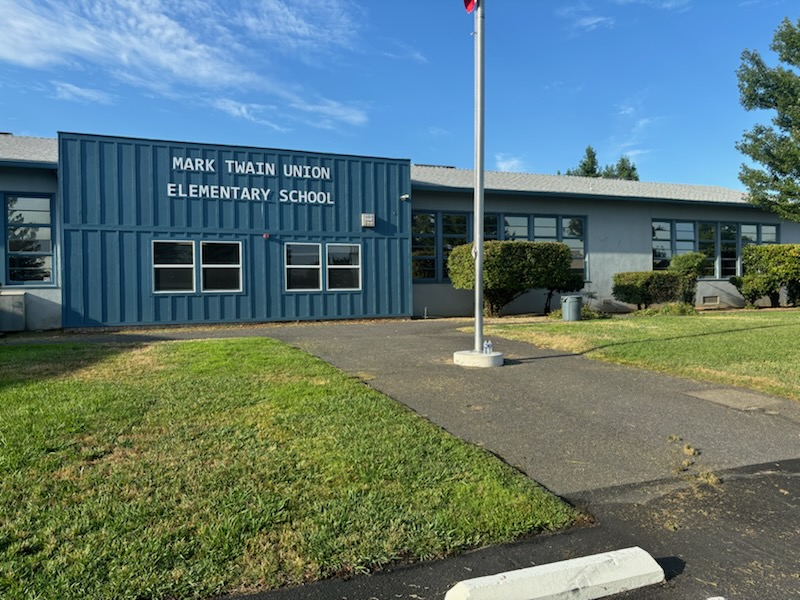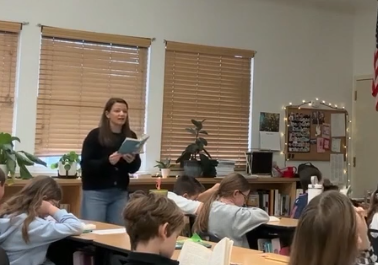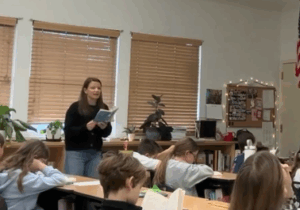
Netty Hull, an instructor in Yakima Valley College’s teacher education program, speaks with a group of students.
Credit: Michael Burke/EdSource
Up the West Coast in Washington state, some students want a bachelor’s degree to enter careers like teaching and nursing but don’t have a local four-year university to attend. Fortunately for them, they have another option: getting that degree from a community college.
It’s an idea that California has taken steps to embrace, with the passage of a law three years ago allowing the state’s community college system to approve up to 30 new bachelor’s degrees annually, not just associate degrees and certificates. But some officials and advocates believe the colleges could be doing more if not for restrictions on what they can offer.
LESSONS IN HIGHER EDUCATION
California leads the nation in many areas of higher education, including educating the largest number of undergraduates at 2.3 million. The state is also grappling with issues that are being tackled by other public universities across the country. This story is part of a continuing EdSource series on issues and innovations that relate to California’s higher education systems.
— Rose Ciotta, Investigations and Projects Editor
The key, they say, is making bachelor’s degrees available to place-bound students — those who can only attend college close to home, usually because of work or family commitments. That has become a reality in Washington state, where community colleges in rural areas can offer essentially any bachelor’s degree as long as they demonstrate there’s a regional workforce need and that students will enroll in the program.
“Just because they’re in an isolated community, that does not mean the community members should not have access to higher education,” said Constance Carroll, president of the California Community College Baccalaureate Association.
In California, community colleges can only offer four-year degrees in programs not offered by the state’s four-year universities. That takes away the option to create degrees in majors like education and nursing, even as those industries face worker shortages. Reversing that would require legislative change and would surely face pushback from California State University. The 23-campus CSU system, with unstable enrollment at several campuses, is loath to lose potential students to the community colleges.
The rules even apply to community colleges in remote and rural areas without a CSU or University of California campus. That’s particularly troublesome for advocates who argue that students in those regions are being left behind. Instead of traveling to another part of the state to attend a CSU or UC campus, in many cases they are not going to college at all, leading to low degree attainment and workforce shortages in those regions.
“Duplication limitations hurt all of our students, especially those who are place-bound,” Melissa Villarin, a spokesperson for the community college system, said in an email.
The landscape could start to change with legislation being considered by California lawmakers, Senate Bill 895. The bill would permit up to 15 community colleges to offer bachelor’s degrees in nursing. If it passes, it could set a precedent for allowing community colleges to offer degrees already offered by CSU.
In Washington, a different reality
Saray Preciado decided to go to college during the Covid-19 pandemic after being laid off from her paralegal job. With a newborn daughter, she wanted to advance her career so her family didn’t have to rely only on her husband’s income.
A resident of Yakima, a city of about 98,000 in central Washington, Preciado initially considered a few colleges, including the closest four-year university, Central Washington University. But the 45-minute commute from Yakima made that untenable. With her husband working until 4 p.m. every day, Preciado needed to be with her daughter during the day.

Yakima Valley, which caters to students like Preciado by offering evening classes, was the obvious choice.
“I’ve always dreamed about being a teacher,” she said. “So I thought, let me just give it a shot.”
She graduated from the program last month and will start in the fall as a bilingual teacher at nearby Moxee Elementary.
Like California, bachelor’s degrees at Washington’s community colleges can’t duplicate what’s offered at the state’s four-year universities. But whether a degree is considered duplicative isn’t as simple as whether a similar program is offered at a four-year college. Officials there consider additional factors, especially location.
“There are a whole lot of students who are choosing not to go into higher ed,” said Valerie Sundby, director of transfer education with the Washington State Board for Community and Technical Colleges. “We’re not competing for the students who are already choosing and have a pathway into higher ed. We’re trying to broaden that pathway.”
Washington’s community colleges have offered bachelor’s degrees since 2005. There are currently 33 colleges offering a total of 165 bachelor’s degrees, including in nursing and teacher education. The state has awarded nearly 1,200 bachelor’s degrees in teacher education and 790 in nursing. Unlike California, where CSU and UC have a say during the approval process for community college bachelor’s degrees, the final approval in Washington rests solely with the community college officials.
Preciado’s experience isn’t an unusual one. For many students in the region, their options are either to attend Yakima Valley College or get no postsecondary degree at all. According to the latest census data, 17.6% of adults in Yakima County have at least a bachelor’s degree, compared with 36.7% statewide.
“One day we have to get beyond that,” said Herlinda Ruvalcaba, Yakima Valley College’s director of applied baccalaureate programs. “Most of the students are here because they’re in the valley. They’re not looking to move. They’re staying here.”
That’s the case for Sofia Gonzalez, who in the fall will enter her final year in the college’s dental hygiene program.
Gonzalez lives with her mother and 8-year-old brother. Her mom is enrolled in English courses at Yakima Valley, and Gonzalez watches her little brother while her mom is at class.
“I’m very family-oriented. I wanted to help her out,” Gonzalez said.
Being able to live at home and not pay rent, making the degree more affordable, was also attractive to Gonzalez.
Gonzalez plans to find a job locally after she gets her degree next year. Most Yakima bachelor’s degree earners remain in the region after graduation, and that’s by design. When community colleges like Yakima are considering a new bachelor’s degree, they’re required to demonstrate that there’s a regional labor market need for that profession, something that’s also required for community college bachelor’s degree programs in California.

In Washington, the degrees are called applied bachelor’s degrees because they are designed to give students applicable experience.
In Yakima Valley’s agricultural sciences bachelor’s program, the capstone project for seniors is to design an agribusiness plan that they can use outside the classroom. For Pedro Huecias, that meant coming up with a plan to own and live off his own vineyard. His project mapped out a multi-year plan to come up with the money to do that.
Huecias, who graduated last month, was one of six students in the agricultural program’s first cohort. He currently works in cheese production for Darigold, a dairy cooperative operating in Washington and three other states. But he’s always dreamed bigger than that: Since he was 14, Huecias and his cousin have planned on one day owning their own vineyard. He’s hopeful his new degree will help him accomplish that.
“I wasn’t happy where I was at, and I needed to do something different,” he said.
California’s landscape
In California, there are 42 bachelor’s degree programs that are currently offered or will be soon across 35 different community colleges. But another eight proposed degrees are currently in limbo because CSU has raised duplication concerns. Four of those degrees have been held up for more than a year.
Beyond that, there are colleges that would like to offer additional bachelor’s degrees but haven’t proposed them because of the duplication law. Francisco Rodriguez, chancellor of the Los Angeles Community College District, the state’s largest district, said colleges “have a strong interest” in being able to offer bachelor’s degrees in a wider array of programs, including education.
“There are workforce shortages, and the community colleges are perfectly situated and positioned to address some of these regional needs,” he said. “My instinct tells me there are enough students for everyone.”
Some shortages are especially dire in the state’s rural counties. Nine of the state’s rural counties are teacher education deserts, having struggled to recruit teachers, concluded a recent report by the UCLA Center for the Transformation of Schools. One of the problems identified in the report is the lack of higher education options in those counties.
The UCLA report suggests allowing community colleges to play a larger role in preparing teachers. That could mean letting community colleges offer credentialing programs for students who already have a bachelor’s degree. It could also include letting the community colleges offer bachelor’s degrees in education, or at least parts of those degrees, said Kai Mathews, project director for the UCLA center that wrote the report.
“We’re in a teacher shortage. We need as many systems and supports and programs as possible to get students engaged into this profession,” Mathews added.
Under current state law, location isn’t considered at all when community colleges propose new bachelor’s degrees. When a degree is being considered, it goes out for review to all 23 CSU campuses, from San Diego to Humboldt.
“We try not to get emotionally involved or even consider it regionally,” said Brent Foster, an assistant vice chancellor at CSU.
State community college officials acknowledge that’s the law but say they wish it were different.
Being able to evaluate “regional labor market needs and the state’s existing ability to meet those demands” could be useful in determining whether a degree is duplicative, said Villarin, the spokesperson for the community college system.
Community college and CSU officials are working to find a third-party organization to serve as something of a mediator between the two sides and help smooth the review process.
At the same time, SB 895, the bill that would allow up to 15 community colleges to offer bachelor’s degrees in nursing, could be a turning point for the state. The bill cleared the Senate and is currently making its way through the Assembly. If signed into law, priority for the degrees would be given to colleges in underserved areas.
The legislation is opposed by CSU and by the Association for Independent California Colleges and Universities (AICCU), which represents the state’s private universities. In an opposition message submitted to lawmakers, the AICCU cited the state’s duplication law.
“Respectfully, we view this proposal to be a significant shift away from that recently agreed upon framework,” the AICCU wrote.
In an analysis of the bill, Senate staff said it “establishes a precedent for permitting duplication of degree programs and expands CCC’s ability to establish baccalaureate degrees independent from California’s other public universities.”
Carroll, whose organization supports the legislation, said the intent is not for the bill to be “a harbinger of lots of duplication.” Instead, she said it was specifically proposed to address nursing shortages facing the state.
Carroll added, though, that she’s hopeful the state will nonetheless be able to offer a wider range of community college bachelor’s degrees at some point in the future.
“As people learn more about it, and they see how the bachelor’s programs have benefited students and local communities, we’re hoping that they will become supportive,” she said.


















